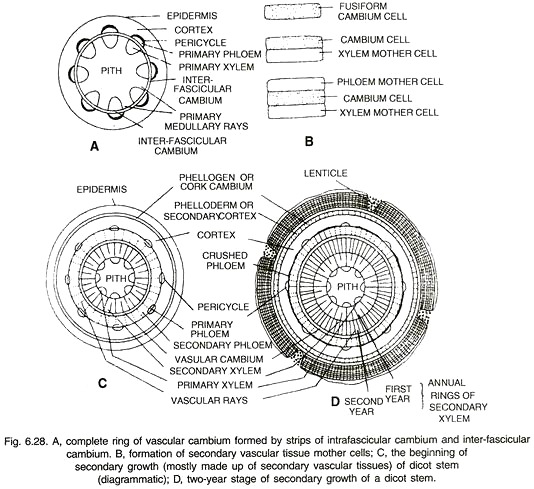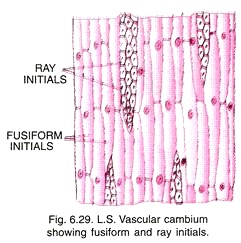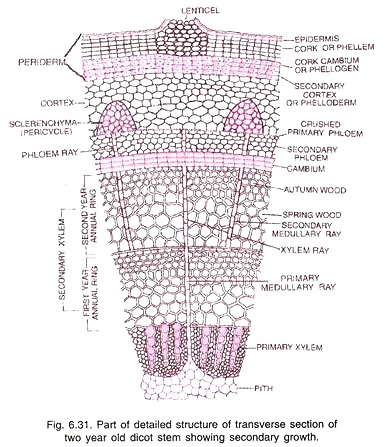ADVERTISEMENTS:
The below mentioned article provides study notes on Secondary Growth in Dicot Stem of plants.
Primary growth produces growth in length and development of lateral appendages. Secondary growth is the formation of secondary tissues from lateral meristems. It increases the diameter of the stem. In woody plants, secondary tissues constitute the bulk of the plant. They take part in providing protection, support and conduction of water and nutrients.
Secondary tissues are formed by two types of lateral meristems, vascular cambium and cork cambium or phellogen. Vascular cambium produces secondary vascular tissues while phellogen forms periderm.
ADVERTISEMENTS:
Secondary growth occurs in perennial gymnosperms and dicots such as trees and shrubs. It is also found in the woody stems of some herbs. In such cases, the secondary growth is equivalent to one annual ring, e.g., Sunflower.
A. Formation of Secondary Vascular Tissues:
They are formed by the vascular cambium. Vascular cambium is produced by two types of meristems, fascicular or intra-fascicular and inter-fascicular cambium. Intra-fascicular cambium is a primary meristem which occurs as strips in vascular bundles. Inter-fascicular cambium arises secondarily from the cells of medullary rays which occur at the level of intra-fascicular strips.
These two types of meristematic tissues get connected to form a ring of vascular cambium. Vascular cambium is truly single layered but appears to be a few layers (2-5) in thickness due to presence of its immediate derivatives. Cells of vascular cambium divide periclinally both on the outer and inner sides (bipolar divisions) to form secondary permanent tissues.
ADVERTISEMENTS:
The cells of vascular cambium are of two types, elongated spindle-shaped fusiform initials and shorter isodiametric ray initials (Fig. 6.29). Both appear rectangular in T.S. Ray initials give rise to vascular rays.
Fusiform initials divide to form secondary phloem on the outer side and secondary xylem on the inner side (Fig. 6.28 B). With the formation of secondary xylem on the inner side, the vascular cambium moves gradually to the outside by adding new cells.
The phenomenon is called dilation. New ray cells are also added. They form additional rays every year (Fig. 6.28 D). The vascular cambium undergoes two types of divisions— additive (periclinal divisions for formation of secondary tissues) and multiplicative (anticlinal divisions for dilation).
Ray initials produce radial system (= horizontal or transverse system) while fusiform initials form axial system (= vertical system) of secondary vascular tissues.
1. Vascular Rays:
The vascular rays or secondary medullary rays are rows of radially arranged cells which are formed in the secondary vascular tissues. They are a few cells in height.
Depending upon their breadth, the vascular rays are uniseriate (one cell in breadth) or multiseriate (two or more cells in breadth). Vascular rays may be homo-cellular (having one type of cells) or hetero-cellular (with more than one type of cells). The cells of the vascular rays enclose intercellular spaces.
The part of the vascular ray present in the secondary xylem is called wood or xylem ray while the part present in the secondary phloem is known as phloem ray. The vascular rays conduct water and organic food and permit diffusion of gases in the radial direction. Besides, their cells store food.
2. Secondary Phloem (Bast):
It forms a narrow circle on the outer side of vascular cambium. Secondary phloem does not grow in thickness because the primary and the older secondary phloem present on the outer side gets crushed with the development of new functional phloem (Fig. 6.28 D). Therefore, rings (annual rings) are not produced in secondary phloem. The crushed or non-functioning phloem may, however, have fibres and sclereids.
Secondary phloem is made up of the same type of cells as are found in the primary phloem (metaphloem)— sieve tubes, companion cells, phloem fibres and phloem parenchyma.
Phloem pairenchyma is of two types— axial phloem parenchyma made up of longitudinally arranged cells and phloem ray parenchyma formed of radially arranged parenchyma cells that constitute the part of the vascular ray present in the phloem.
ADVERTISEMENTS:
Elements of secondary phloem show a more regular arrangement. Sieve tubes are comparatively more numerous but are shorter and broader. Sclerenchyma fibres occur either in patches or bands. Sclereids are found in many cases. In such cases secondary phloem is differentiated into soft bast (secondary phloem without fibres) and hard bast (part of phloem with abundant fibres).
3. Secondary Xylem:
It forms the bulk of the stem and is commonly called wood. The secondary xylem consists of vessels, tracheids (both tracheary elements), wood fibres and wood parenchyma.
ADVERTISEMENTS:
Wood parenchyma may contain tannins and crystals besides storing food. It is of two types— axial parenchyma cells arranged longitudinally and radial ray parenchyma cells arranged in radial or horizontal fashion. The latter is part of vascular ray present in secondary xylem.
Secondary xylem does not show distinction into protoxylem and meta-xylem elements. Therefore, vessels and tracheids with annular and spiral thickenings are absent. The tracheary elements of secondary xylem are similar to those of meta-xylem of the primary xylem with minor differences. They are comparatively shorter and more thick-walled. Pitted thickenings are more common. Fibres are abundant.
Width of secondary xylem grows with the age of the plant. The primary xylem persists as conical projection on its inner side. Pith may become narrow and ultimately get crushed. The yearly growth of secondary xylem is distinct in the areas which experience two seasons, one favourable spring or rainy season) and the other un-favourable (autumn, winter or dry summer).
In favourable season the temperature is optimum. There is a good sunshine and humidity. At this time the newly formed leaves produce hormones which stimulate cambial activity. The activity decreases and stops towards the approach of un-favourable season. Hence the annual or yearly growth appears in the form of distinct rings which are called annual rings (Fig. 6.30).
ADVERTISEMENTS:
Annual rings are formed due to sequence of rapid growth (favourable season, e.g., spring), slow growth (before the onset of un-favourable period, e.g., autumn) and no growth (un-favourable season, e.g., winter). Annual rings are not distinct in tropical areas which do not have long dry periods.
Annual Rings (Growth Rings). It is the wood formed in a single year. It consists of two types of wood, spring wood and autumn wood (Fig. 6.31). The spring or early wood is much wider than the autumn or late wood. It is lighter in colour and of lower density. Spring wood consists of larger and wider xylem elements.
The autumn or late wood is dark coloured and of higher density. It contains compactly arranged smaller and narrower elements which have comparatively thicker walls. In autumn wood, tracheids and fibres are more abundant than those found in the spring wood.
The transition from spring to autumn wood in an annual ring is gradual but the transition from autumn wood to the spring wood of the next year is sudden. Therefore, each year’s growth is quite distinct. The number of annual rings corresponds to the age of that part of the stem. (They can be counted by increment borer).
Besides giving the age of the plant, the annual rings also give some clue about the climatic conditions of the past through which the plant has passed. Dendrochronology is the science of counting and analysing annual growth rings of trees.
Softwood and Hardwood:
Softwood is the technical name of gymnosperm wood because it is devoid of vessels. Several of the softwoods are very easy to work with (e.g., Cedrus, Pinus species). However, all of them are not ‘soft’. The softness depends upon the content of fibres and vascular rays. 90-95% of wood is made of tracheids and fibres. Vascular rays constitute 5-10% of the wood.
Hardwood is the name of dicot wood which possesses abundant vessels. Due to the presence of vessels, the hardwoods are also called porous woods. In Cassia fistula and Dalbergia sisso the vessels are comparatively very broad in the spring wood while they are quite narrow in the autumn wood. Such a secondary xylem or wood is called ring porous.
In others (e.g., Syzygium cumini) larger sized vessels are distributed throughout spring wood and autumn wood. This type of secondary xylem or wood is known as diffuse porous. Ring porous wood is more advanced than diffuse porous wood as it provides for better translocation when the requirement of the plant is high.
Sapwood and Heartwood:
ADVERTISEMENTS:
The wood of the older stems (dalbergia, Acacia) gets differentiated into two zones, the outer light coloured and functional sapwood or alburnum and the inner darker and nonfunctional heartwood or duramen (Fig. 6.33). The tracheids and vessels of the heart wood get plugged by the in growth of the adjacent parenchyma cells into their cavities through the pits. These ingrowths are called tyloses (Fig. 6.32).
Ultimately, the parenchyma cells become lignified and dead. Various types of plant products like oils, resins, gums, aromatic substances, essential oils and tannins are deposited in the cells of the heartwood. These substances are collectively called extractives. They provide colour to the heartwood. They are also antiseptic. The heartwood is, therefore, stronger and more durable than the sapwood.
It is resistant to attack of insects and microbes. Heart wood is commercial source of Cutch (Acacia catechu), Haematoxylin (Haematoxylon campechianum), Brasilin (Caesalpinia sappan) and Santalin (Pterocarpus santalinus). Heartwood is, however, liable to be attacked by wood rotting fungi. Hollow tree trunks are due to their activity.
B. Formation of Periderm:
In order to provide for increase in girth and prevent harm on the rupturing of the outer ground tissues due to the formation of secondary vascular tissues, dicot stems produce a cork cambium or phellogen in the outer cortical cells. Rarely it may arise from the epidermis (e.g., Teak, Oleander), hypodermis (e.g., Pear) or phloem parenchyma.
Phellogen cells divide on both the outer side as well as the inner side (bipolar) to form secondary tissues. The secondary tissue produced on the inner side of the phellogen is parenchymatous or collenchymatous. It is called secondary cortex or phelloderm. Its cells show radial arrangement.
Phellogen produces cork or phellem on the outer side. It consists of dead and compactly arranged rectangular cells that possess suberised cell walls. The cork cells contain tannins. Hence, they appear brown or dark brown in colour. The cork cells of some plants are filled with air e.g., Quercus suber (Cork Oak or Bottle Cork). The phelloderm, phellogen and phellem together constitute the periderm (Fig. 6.34).
Cork prevents the loss of water by evaporation. It also protects the interior against entry of harmful micro-organisms, mechanical injury and extremes of temperature. Cork is light, compressible, nonreactive and sufficiently resistant to fire.
It is used as stopper for bottles, shock absorption and insulation. At places phellogen produces aerating pores instead of cork. These pores are called lenticels. Each lenticel is filled by a mass of somewhat loosely arranged suberised cells called complementary cells.
Lenticels:
Lenticels are aerating pores in the bark of plants. They appear on the surface of the bark as raised scars containing oval, rounded or oblong depressions (Fig. 6.34 A). They occur in woody trees but not in climbers. Normally they are formed in areas with underlying rays for facilitating gas exchange. Lenticels may occur scattered or form longitudinal rows.
A lenticel is commonly produced beneath a former stomate or stoma of the epidermis. Its margin is raised and is formed by surrounding cork cells. The lenticel is filled up by loosely arranged thin walled rounded and suberised (e.g., Prunus) or un-suberised cells called complementary cells (Fig. 6.34 B).
They enclose intercellular spaces for gaseous exchange. The complementary cells are formed from loosely arranged phellogen cells and division of sub-stomatal parenchyma cells. The suberised nature of complementary cells checks excessive evaporation of water.
In temperate plants the lenticels get closed during the winter by the formation of compactly arranged closing cells over the complementary cells.
Bark:
In common language and economic botany, all the dead cells lying outside phellogen are collectively called bark. The outer layers of the bark are being constantly peeled off on account of the formation of new secondary vascular tissues in the interior. The peeling of the bark may occur in sheets (sheets or ring bark, e.g., Eucalyptus) or in irregular strips (scaly bark).
The scaly bark is formed when the phellogen arises in strips instead of rings, e.g., Acacia (vem. Kikar). Bark formed in early growing season is early or soft bark. The one formed towards end of growing season is late or hard bark.
ADVERTISEMENTS:
Bark is insect repellent, decay proof, fire-proof and acts as a heat screen. Commercially it is employed in tanning (e.g., Acacia), drugs (e.g., Cinchona— quinine) or as spice (e.g., Cannamon, vem. Dalchini). The cork of Quercus suber is employed in the manufacture of bottle stoppers, insulators, floats, sound proofing and linoleum.
Significance of Secondary Growth:
1. Secondary growth adds to the girth of the plant. It provides support to increasing weight of the aerial growth.
2. Secondary growth produces a corky bark around the tree trunk that protects the interior from abrasion, heat, cold and infection.
3. It adds new conducting tissues for replacing old non-functioning ones as well as for meeting increased demand for long distance transport of sap and organic nutrients.
Anomalous Secondary Growth:
It is abnormal type of secondary growth that occurs in some arborescent monocots (e.g., Dracaena, Yucca, Agave) and storage roots (e.g., Beet, Sweet Potato). In arborescent monocot stems, a secondary cambium grows in hypodermal region. The latter forms conjunctive tissue and patches of meristematic cells. The meristematic patches grow into secondary vascular bundles.
Anomalous vascular bundles also occur in cortex (cortical bundles, e.g., Nyctanthes) and pith (e.g., Boerhaavia). In storage roots (e.g., Beet), accessory cambial rings appear on the outside of endodermis. They produce less secondary xylem but more secondary phloem. The secondary phloem contains abundant storage parenchyma.
Importance of Secondary Growth:
1. It is a means of replacement of old non-functional tissues with new active tissues.
2. The plants showing secondary growth can grow and live longer as compared to other plants.
3. It provides a fire proof, insect proof and insulating cover around the older plant parts.
4. Commercial cork is a product of secondary growth. It is obtained from Quercussuber (Cork Oak).
5. Wood is a very important product of secondary growth. It represents secondary xylem.







